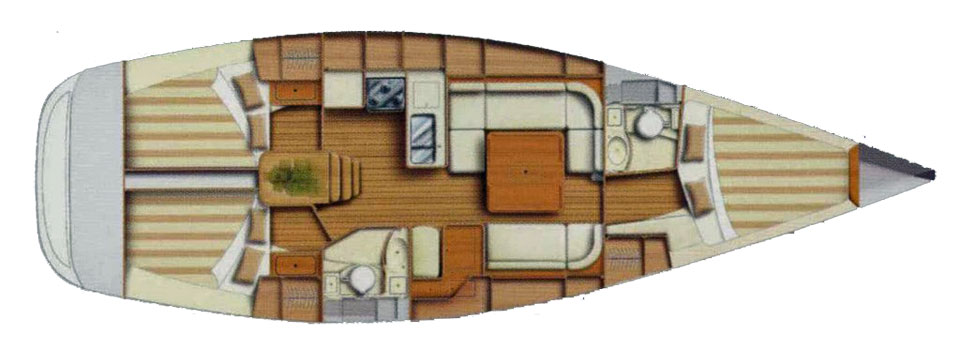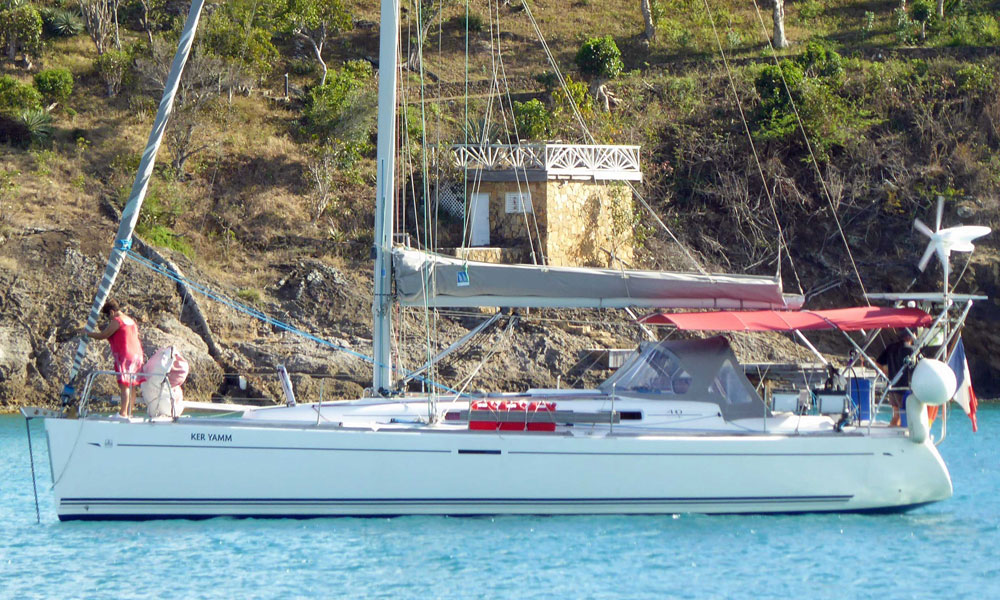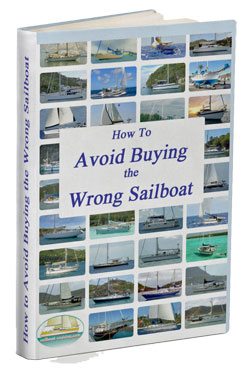- Home
- Cruising Yachts 40' to 45'
- Dufour 40e
The Dufour 40e Sailboat
Specs & Key Performance Indicators
The Dufour 40e sailboat is a performance cruiser designed by Umberto Felci and built by Dufour Yachts in France. It is a fast, responsive, and comfortable boat that can be used for both racing and cruising.
Published Specification for the Dufour 40e
Underwater Profile: Bulb fin keel and spade rudder
Hull Material: GRP
Length Overall: 40'5" (12.4m)
Waterline Length: 35'3" (10.8m)
Beam: 12'9" (3.9m)
Draft: 6'10" (2.1m)
Rig Type: Fractional sloop
Displacement: 16,283lb (7,386kg)
Designer: Umberto Felci and Patrick Roséo
Builder: Dufour Yachts (France)
Year First Built: 2002
Owners Association: Dufour Owners Association
Published Design Ratios for the Dufour 40e
1. Sail Area/Displacement Ratio: 23.8
2. Ballast/Displacement Ratio: 30.0
3. Displacement/Length Ratio: 178
4. Comfort Ratio: 24.7
5. Capsize Screening Formula: 2.0
Summary Analysis of the Design Ratios for the Dufour 40e
1. A Sail Area/Displacement Ratio of 23.8 suggests that, in the right hands, the Dufour 40e will have enough performance to leave most other sailboats of similar waterline length well astern.
2. A Ballast/Displacement Ratio of 30.0 would usually mean that the Dufour 40e would have a tendency to heel excessively in a gust, and need to be reefed early to keep her sailing upright in a moderate breeze.
However, as she has much of her ballast concentrated in a bulb at the foot of the keel, she's likely to be considerably stiffer than her published Ballast/Displacement Ratio might suggest.
3. A Displacement/Length Ratio of 178, tells us the Dufour 40e is clearly a light displacement sailboat. If she's loaded with too much heavy cruising gear her performance will suffer dramatically.
4. Ted Brewer's Comfort Ratio of 24.7 suggests that crew comfort of a Dufour 40e in a seaway is similar to what you would associate with the motion of a coastal cruiser with moderate stability, which is not encouraging news for anyone prone to seasickness.
5. The Capsize Screening Formula (CSF) of 2.0 indicates that a Dufour 40e would not be the wisest choice of sailboat for ocean passage-making owing to the lower resistance to capsize in strong winds and heavy seas that is associated with sailboats with a CSF of 2.0 and above.
 Dufour 40e accommodation layout
Dufour 40e accommodation layoutCruisers' Questions about this Sailboat...
What is the layout of the interior accommodation for the Dufour 40e?
What is the layout of the interior accommodation for the Dufour 40e?
The Dufour 40e sailboat has a choice of three layouts with two or three staterooms and one or two head/shower compartments, depending on the preference and needs of the owner.
The standard layout has three staterooms and one head/shower compartment. The forward stateroom has a double berth, a hanging locker, and a vanity desk. The aft staterooms have double berths and storage lockers. The head/shower compartment is located aft to port, with access from the saloon and the port stateroom.
The optional layouts have two staterooms and either one or two head/shower compartments. The two-stateroom layout with one head/shower compartment has a larger forward stateroom with an en suite head/shower compartment and more storage space. The two-stateroom layout with two head/shower compartments has a smaller forward stateroom with an en suite head/shower compartment and a larger aft stateroom with an en suite head/shower compartment.
How many versions of the Dufour 40e sailboat were produced and how do they differ?
How many versions of the Dufour 40e sailboat were produced and how do they differ?
There were two versions of the Dufour 40e sailboat produced: the Dufour 40e Performance and the Dufour 40e Grand Prix. They differ in some aspects of their design, equipment, and performance.
The Dufour 40e Performance is the standard version of the boat, designed for both racing and cruising. It has a fractional sloop rig with a keel-stepped mast, double swept-back spreaders, and a below-decks furler. It has a bulb fin keel and a spade rudder. It has a Volvo 40 hp engine and a fuel capacity of 58 gallons (220 liters). It has a choice of three layouts with two or three staterooms and one or two head/shower compartments. It has a spacious and bright saloon, with plenty of hatches, portlights, and hull windows. It has a generous galley, with ample storage and counter space.
The Dufour 40e Grand Prix is a more performance-oriented version of the boat, designed for competitive racing. It has a carbon mast and boom, rod rigging, and a hydraulic backstay adjuster. It has a deeper keel and a lighter ballast. It has a Volvo 55 hp engine and a fuel capacity of 42 gallons (160 litres). It has a two-stateroom layout with one head/shower compartment. It has a more minimalist interior, with less furniture and more carbon fibre accents. It has fewer hatches, portlights, and hull windows. It has a smaller galley, with less storage and counter space.
The Dufour 40e Grand Prix is faster, more manoeuvrable, and more responsive than the Dufour 40e Performance, but it is also more expensive, more demanding, and less comfortable. The choice between the two versions depends on the preferences and needs of the owner.
What are the main features of the Dufour 40e sailboat?
What are the main features of the Dufour 40e sailboat?
The Dufour 40e sailboat has a sleek and elegant profile, with a low cabin top and a flush deck. It has a T-shaped cockpit with twin wheels, a full-width traveller, and a fold-down swim platform. It has a fractional sloop rig with a keel-stepped mast, double swept-back spreaders, and a below-decks furler. It has a bulb fin keel and a spade rudder. It has three or two staterooms and one or two head/shower compartments, depending on the layout option. It has a spacious and bright saloon, with plenty of hatches, portlights, and hull windows. It has a generous galley, with ample storage and counter space.
How does the Dufour 40e sailboat perform in different conditions?
How does the Dufour 40e sailboat perform in different conditions?
The Dufour 40e sailboat is a light and fast boat that performs well in various wind and sea conditions. It is easy to sail and handle, with a balanced and responsive helm. It can reach speeds of up to 7.5 knots upwind and over 10 knots downwind in a moderate breeze. It is stable and stiff, with a good righting capability if capsized. It is also comfortable and seaworthy, with a smooth motion in waves.
How much should I expect to pay for a secondhand Dufour 40e?Question
How much should I expect to pay for a secondhand Dufour 40e?Question
The secondhand Dufour 40e price varies depending on the condition, age, equipment, and location of the boat. According to the web search results, the average price range for a used Dufour 40e sailboat is between £81,210 and £149,598. However, some boats may be cheaper or more expensive than this range, depending on various factors.
If you are interested in buying a secondhand Dufour 40e sailboat, you may want to consider some of the following aspects:
- The version of the boat: there are two versions of the Dufour 40e sailboat, the Performance and the Grand Prix. The Grand Prix is more performance-oriented and has a carbon mast and boom, a deeper keel, a lighter ballast, and a more minimalist interior. The Performance is more versatile and has a standard mast and boom, a shallower keel, a heavier ballast, and a more spacious and bright interior. The Grand Prix is usually more expensive than the Performance, but it may also be faster and more responsive;
- The layout of the boat: there are three layout options for the Dufour 40e sailboat, with two or three staterooms and one or two head/shower compartments. The standard layout has three staterooms and one head/shower compartment. The optional layouts have two staterooms and either one or two head/shower compartments. The layout choice depends on your preference and needs for space and comfort;
- The condition of the boat: the condition of the boat affects its value and performance. You may want to check the hull, deck, rigging, sails, engine, electronics, plumbing, and other systems for any signs of damage, wear, or malfunction. You may also want to inspect the interior for any stains, cracks, leaks, or odors. You may want to hire a professional surveyor to evaluate the boat before buying it;
- The location of the boat: the location of the boat affects its availability and cost. You may want to look for boats that are close to your desired sailing area or have easy access to transportation. You may also want to consider the local market conditions, such as supply and demand, taxes, fees, regulations, and currency exchange rates.
The above answers were drafted by sailboat-cruising.com using GPT-4 (OpenAI’s large-scale language-generation model) as a research assistant to develop source material; to the best of our knowledge, we believe them to be accurate.
Recent Articles
-
Hans Christian 43: Classic Bluewater Cruiser & Liveaboard Sailboat
Dec 10, 25 04:37 AM
Explore the Hans Christian 43: a legendary heavy-displacement, long-keel sailboat. Read our in-depth review of its specs, design ratios, and suitability for offshore cruising and living aboard. -
Planning Your Sailboat Liveaboard Lifestyle: An Ocean Sailor's Guide
Dec 06, 25 05:18 AM
Seasoned sailors share their methodical risk analysis for planning a secure Sailboat Liveaboard Lifestyle, covering financial, property, and relationship risks. -
Marine Cabin Heaters: The Expert’s Guide to Comfort & Safety at Sea
Dec 05, 25 06:52 AM
Choose the best Marine Cabin Heaters for your vessel. Expert advice on diesel, paraffin, and hot water systems for year-round cruising comfort.














